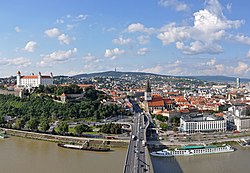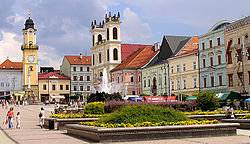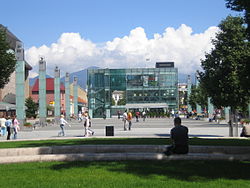List of Hungarian exonyms for places in Slovakia. These names are used by the Hungarian ethnic minority in Slovakia, and they are also used in Hungary and other countries in the Central Europe, which are home of Hungarian minorities. In communities in Slovakia where the ethnic minority represents 20% or more of the population, it has certain cultural and linguistic rights.















| Slovak name | Hungarian name | German name |
|---|---|---|
| Bratislava | Pozsony | Preßburg/Pressburg |
| Košice | Kassa | Kaschau |
| Prešov | Eperjes | Eperies / Preschau |
| Žilina | Zsolna | Sillein |
| Banská Bystrica | Besztercebánya | Neusohl |
| Nitra | Nyitra | Neutra |
| Trnava | Nagyszombat | Tyrnau |
| Trenčín | Trencsén | Trentschin |
| Martin | Turócszentmárton | (Turz-) St. Martin |
| Poprad | Poprád | Deutschendorf |
| Prievidza | Privigye | Priwitz |
| Zvolen | Zólyom | Altsohl |
| Považská Bystrica | Vágbeszterce | Waagbistritz |
| Michalovce | Nagymihály | Großmichel |
| Nové Zámky | Érsekújvár | Neuhäus[e]l |
| Spišská Nová Ves | Igló | (Zipser) Neudorf / Neuendorf |
| Komárno | Komárom | Komorn |
| Humenné | Homonna | Homenau |
| Levice | Léva | Lewenz |
| Bardejov | Bártfa | Bartfeld |
| Liptovský Mikuláš | Liptószentmiklós | Liptau - St. Nikolaus |
| Lučenec | Losonc | Lizenz |
| Piešťany | Pöstyén | Pistyan / (rarely:) Püschtin |
| Ružomberok | Rózsahegy | Rosenberg |
| Topoľčany | Nagytapolcsány | Topoltschan |
| Trebišov | Tőketerebes | Trebischau |
| Čadca | Csaca | Tschadsa (rare) |
| Rimavská Sobota | Rimaszombat | Großsteffelsdorf |
| Dubnica nad Váhom | Máriatölgyes | Dubnitz an der Waag |
| Pezinok | Bazin | Bösing |
| Dunajská Streda | Dunaszerdahely | Niedermarkt (very rare) |
| Vranov nad Topľou | Varannó | Frö(h)nel/Vronau an der Töpl |
| Partizánske | Simony | |
| Šaľa | Vágsellye | Schelle |
| Hlohovec | Galgóc | Freistadtl/Freistadt an der Waag |
| Brezno | Breznóbánya | Bries an der Gran |
| Senica | Szenice | Senitz |
| Nové Mesto nad Váhom | Vágújhely | Neustadt an der Waag / (rarely) Neustadtl |
| Senec | Szenc | Wartberg |
| Snina | Szinna | Snina |
| Rožňava | Rozsnyó | Rosenau |
| Žiar nad Hronom | Garamszentkereszt | Heiligenkreuz |
| Dolný Kubín | Alsókubin | Unterkubin |
| Bánovce nad Bebravou | Bán | Banowitz |
| Púchov | Puhó | Puchau |
| Malacky | Malacka | Malatzka |
| Handlová | Nyitrabánya | Krickerhau / Krickerhäu / Kreckerhaj |
| Kežmarok | Késmárk | Kesmark / Käsmark |
| Stará Ľubovňa | Ólubló | Altlublau |
| Sereď | Szered | |
| Kysucké Nové Mesto | Kiszucaújhely | Kis(s)utz-Neustadtl |
| Skalica | Szakolca | Skalitz |
| Galanta | Galánta | Gallandau |
| Levoča | Lőcse | Leutschau |
| Detva | Gyetva, Dettva | |
| Šamorín | Somorja | Sommerein |
| Sabinov | Kisszeben | Zeben |
| Revúca | Nagyrőce | Groß-Rauschenbach (rare) |
| Veľký Krtíš | Nagykürtös | |
| Stupava | Stomfa | Stampfen |
| Myjava | Miava | Miawa (rare) |
| Zlaté Moravce | Aranyosmarót | Goldmorawitz |
| Bytča | Nagybiccse | Großbitsch |
| Moldava nad Bodvou | Szepsi | Moldau (an der Bodwa) |
| Holíč | Holics | Weißkirchen/Holitsch |
| Nová Dubnica | Újtölgyes | Neudubnitz |
| Svidník | Felsővízköz | Oberswidnik |
| Fiľakovo | Fülek | Fülleck |
| Stropkov | Sztropkó | Stroppkau |
| Kolárovo | Gúta | |
| Štúrovo | Párkány | Parkan |
| Banská Štiavnica | Selmecbánya | Schemnitz |
| Šurany | Surány | Schuran (rare) |
| Tvrdošín | Turdossin | Turdoschin |
| Modra | Modor | Modern |
| Veľké Kapušany | Nagykapos | |
| Stará Turá | Ótura | Alt-Turn |
| Krompachy | Korompa | Krompach |
| Veľký Meder | Nagymegyer | |
| Vráble | Verebély | |
| Sečovce | Gálszécs | |
| Krupina | Korpona | Karpfen |
| Námestovo | Námesztó | |
| Svit | Szvit | Svit |
| Vrútky | Ruttka | Ruttek (rare) |
| Turzovka | Turzófalva | |
| Hriňová | Herencsvölgy | Hrinau |
| Hurbanovo | Ógyalla | Altdala |
| Hnúšťa | Nyustya | Nusten |
| Liptovský Hrádok | Liptóújvár | Neuhäusel in der Liptau |
| Kráľovský Chlmec | Királyhelmec | |
| Trstená | Trsztena | B[r]ingenstadt |
| Nová Baňa | Újbánya | Königsberg an der Gran |
| Šahy | Ipolyság | Eipelschlag |
| Tornaľa | Tornalja | |
| Krásno nad Kysucou | Krasznó | Crassna |
| Želiezovce | Zselíz | Zelis |
| Spišská Belá | Szepesbéla | Zipser Bela |
| Medzilaborce | Mezőlaborc | |
| Lipany | Héthárs | Siebenlinden |
| Nemšová | Nemsó | |
| Turčianske Teplice | Stubnyafürdő | Bad Stuben |
| Sobrance | Szobránc | Sobranz |
| Veľký Šariš | Nagysáros | Großscharosch |
| Žarnovica | Zsarnóca | Scharnowitz |
| Gelnica | Gölnicbánya | Göllnitz |
| Vrbové | Verbó | Werbau |
| Rajec | Rajec | Rajetz |
| Svätý Jur | Szentgyörgy | St.Georgen |
| Dobšiná | Dobsina | Dobschau |
| Poltár | Poltár | |
| Ilava | Illava | Illau (very rare) |
| Gabčíkovo | Bős | |
| Kremnica | Körmöcbánya | Kremnitz |
| Sládkovičovo | Diószeg | (Klein- + Groß)Diosek |
| Gbely | Egbell | Egbell |
| Nesvady | Naszvad | |
| Sliač | Szliács | |
| Šaštín-Stráže | Sasvár | Sassin/Ews |
| Bojnice | Bajmóc | Weinitz |
| Brezová pod Bradlom | Berezó | Birkenhain |
| Medzev | Mecenzéf | Metzenseifen |
| Strážske | Őrmező | Straschke |
| Turany | Nagyturány | |
| Nováky | Nyitranovák | |
| Trenčianske Teplice | Trencsénteplic | Trentschinteplitz |
| Leopoldov | Újvároska | Leopoldstadt |
| Tisovec | Tiszolc | Theißholz / (rarely) Theisscholz |
| Giraltovce | Girált | |
| Vysoké Tatry | Magastátra | Hohe Tatra |
| Spišské Podhradie | Szepesváralja | Kirchdrauf |
| Hanušovce nad Topľou | Tapolyhanusfalva | |
| Čierna nad Tisou | Tiszacsernyő | |
| Tlmače | Garamtolmács | |
| Spišské Vlachy | Szepesolaszi | Wallendorf |
| Jelšava | Jolsva | Eltsch |
| Podolínec | Podolin | Pudlein |
| Rajecké Teplice | Rajecfürdő | Bad Rajetz |
| Spišská Stará Ves | Szepesófalu | Altendorf |
| Modrý Kameň | Kékkő | Blauenstein |
| Vlčany | Vágfarkasd | |
| Neded | Negyed | |
| Dudince | Gyűgy | Dudintze |